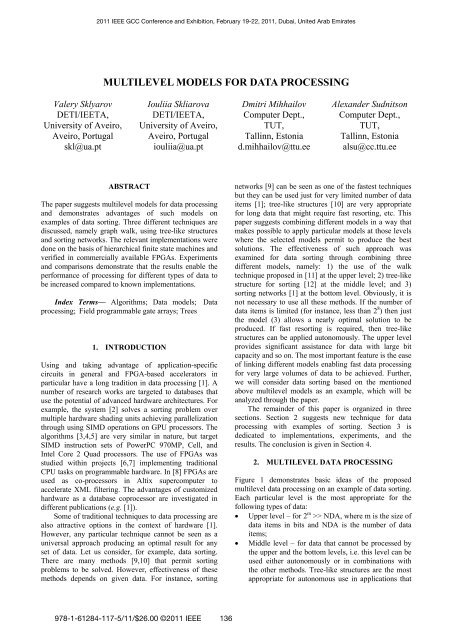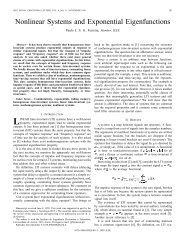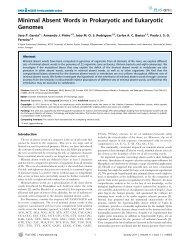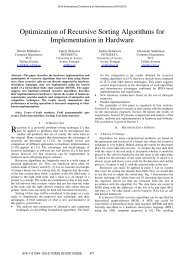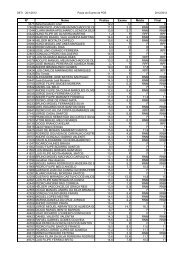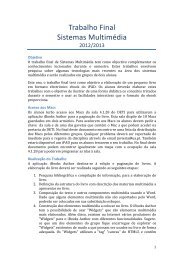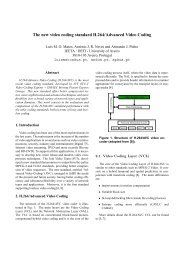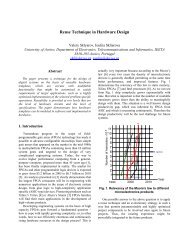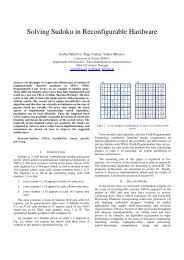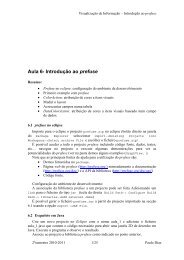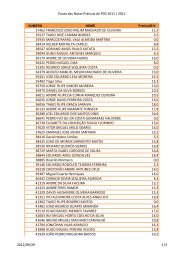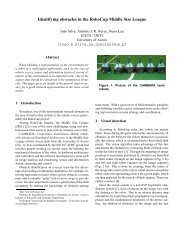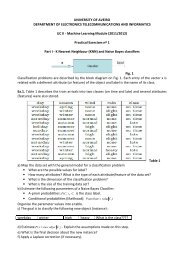Multilevel Models for Data Processing - ResearchGate
Multilevel Models for Data Processing - ResearchGate
Multilevel Models for Data Processing - ResearchGate
You also want an ePaper? Increase the reach of your titles
YUMPU automatically turns print PDFs into web optimized ePapers that Google loves.
2011 IEEE GCC Conference and Exhibition, February 19-22, 2011, Dubai, United Arab Emirates<br />
MULTILEVEL MODELS FOR DATA PROCESSING<br />
Valery Sklyarov<br />
DETI/IEETA,<br />
University of Aveiro,<br />
Aveiro, Portugal<br />
skl@ua.pt<br />
Iouliia Skliarova<br />
DETI/IEETA,<br />
University of Aveiro,<br />
Aveiro, Portugal<br />
iouliia@ua.pt<br />
Dmitri Mihhailov<br />
Computer Dept.,<br />
TUT,<br />
Tallinn, Estonia<br />
d.mihhailov@ttu.ee<br />
Alexander Sudnitson<br />
Computer Dept.,<br />
TUT,<br />
Tallinn, Estonia<br />
alsu@cc.ttu.ee<br />
ABSTRACT<br />
The paper suggests multilevel models <strong>for</strong> data processing<br />
and demonstrates advantages of such models on<br />
examples of data sorting. Three different techniques are<br />
discussed, namely graph walk, using tree-like structures<br />
and sorting networks. The relevant implementations were<br />
done on the basis of hierarchical finite state machines and<br />
verified in commercially available FPGAs. Experiments<br />
and comparisons demonstrate that the results enable the<br />
per<strong>for</strong>mance of processing <strong>for</strong> different types of data to<br />
be increased compared to known implementations.<br />
Index Terms— Algorithms; <strong>Data</strong> models; <strong>Data</strong><br />
processing; Field programmable gate arrays; Trees<br />
1. INTRODUCTION<br />
Using and taking advantage of application-specific<br />
circuits in general and FPGA-based accelerators in<br />
particular have a long tradition in data processing [1]. A<br />
number of research works are targeted to databases that<br />
use the potential of advanced hardware architectures. For<br />
example, the system [2] solves a sorting problem over<br />
multiple hardware shading units achieving parallelization<br />
through using SIMD operations on GPU processors. The<br />
algorithms [3,4,5] are very similar in nature, but target<br />
SIMD instruction sets of PowerPC 970MP, Cell, and<br />
Intel Core 2 Quad processors. The use of FPGAs was<br />
studied within projects [6,7] implementing traditional<br />
CPU tasks on programmable hardware. In [8] FPGAs are<br />
used as co-processors in Altix supercomputer to<br />
accelerate XML filtering. The advantages of customized<br />
hardware as a database coprocessor are investigated in<br />
different publications (e.g. [1]).<br />
Some of traditional techniques to data processing are<br />
also attractive options in the context of hardware [1].<br />
However, any particular technique cannot be seen as a<br />
universal approach producing an optimal result <strong>for</strong> any<br />
set of data. Let us consider, <strong>for</strong> example, data sorting.<br />
There are many methods [9,10] that permit sorting<br />
problems to be solved. However, effectiveness of these<br />
methods depends on given data. For instance, sorting<br />
networks [9] can be seen as one of the fastest techniques<br />
but they can be used just <strong>for</strong> very limited number of data<br />
items [1]; tree-like structures [10] are very appropriate<br />
<strong>for</strong> long data that might require fast resorting, etc. This<br />
paper suggests combining different models in a way that<br />
makes possible to apply particular models at those levels<br />
where the selected models permit to produce the best<br />
solutions. The effectiveness of such approach was<br />
examined <strong>for</strong> data sorting through combining three<br />
different models, namely: 1) the use of the walk<br />
technique proposed in [11] at the upper level; 2) tree-like<br />
structure <strong>for</strong> sorting [12] at the middle level; and 3)<br />
sorting networks [1] at the bottom level. Obviously, it is<br />
not necessary to use all these methods. If the number of<br />
data items is limited (<strong>for</strong> instance, less than 2 8 ) then just<br />
the model (3) allows a nearly optimal solution to be<br />
produced. If fast resorting is required, then tree-like<br />
structures can be applied autonomously. The upper level<br />
provides significant assistance <strong>for</strong> data with large bit<br />
capacity and so on. The most important feature is the ease<br />
of linking different models enabling fast data processing<br />
<strong>for</strong> very large volumes of data to be achieved. Further,<br />
we will consider data sorting based on the mentioned<br />
above multilevel models as an example, which will be<br />
analyzed through the paper.<br />
The remainder of this paper is organized in three<br />
sections. Section 2 suggests new technique <strong>for</strong> data<br />
processing with examples of sorting. Section 3 is<br />
dedicated to implementations, experiments, and the<br />
results. The conclusion is given in Section 4.<br />
2. MULTILEVEL DATA PROCESSING<br />
Figure 1 demonstrates basic ideas of the proposed<br />
multilevel data processing on an example of data sorting.<br />
Each particular level is the most appropriate <strong>for</strong> the<br />
following types of data:<br />
• Upper level – <strong>for</strong> 2 m >> NDA, where m is the size of<br />
data items in bits and NDA is the number of data<br />
items;<br />
• Middle level – <strong>for</strong> data that cannot be processed by<br />
the upper and the bottom levels, i.e. this level can be<br />
used either autonomously or in combinations with<br />
the other methods. Tree-like structures are the most<br />
appropriate <strong>for</strong> autonomous use in applications that<br />
978-1-61284-117-5/11/$26.00 ©2011 IEEE 136
equire very fast resorting in case of arriving<br />
additional data items;<br />
• Bottom level – as a rule <strong>for</strong> n ≤ 8 or even smaller,<br />
which depends on available resources, where n is the<br />
selected number of the less significant bits of data<br />
items.<br />
Upper level: search a group where<br />
the new item has to be included or<br />
allocating a new group in memory<br />
Middle level: 1. <strong>Processing</strong> binary<br />
trees associated with each group;<br />
2. Creating new groups associated<br />
with leaves of trees<br />
Bottom level: <strong>Processing</strong> items<br />
associated with the leaves of the<br />
trees by sorting networks<br />
Figure 1. <strong>Multilevel</strong> data processing on an example of data<br />
sorting<br />
2.1. Tree walk technique<br />
Suppose we need to sort m-bit data items. Let us<br />
decompose m-bit binary values in 2 N groups that differ<br />
by the N most significant bits. Let us assume that data<br />
items within each group will be sorted by applying some<br />
methods, which we will discuss a bit later. At the upper<br />
level we have to find a proper group <strong>for</strong> any new<br />
incoming data item. In practical cases <strong>for</strong> data with large<br />
bit capacity (<strong>for</strong> instance, more than 64) the number of<br />
groups is significantly less than 2 N . Thus, we can apply<br />
the technique [11] proposed <strong>for</strong> accelerating Boolean<br />
constraint propagation needed <strong>for</strong> solving the SAT<br />
problem with large number of variables and limited<br />
number of clauses.<br />
Figure 2 demonstrates an example, taken from [11],<br />
in which we consider groups instead of clauses. Similar<br />
to [11] the group index walk module uses a tree to<br />
efficiently locate the group associated with any new<br />
incoming data item. The tree will be N/k deep and it is<br />
stored in the tree walk table in an on-chip BRAM block.<br />
Here we consider 2 k -nary trees and N/k is the number of<br />
assigned levels of the tree, through which the walk<br />
procedure from the root of the tree to a leaf (associated<br />
with a particular group) will be done. If k=1 we have a<br />
binary tree. The greater the number k the less number of<br />
levels of the tree we need <strong>for</strong> our walk procedure. Given<br />
a non-leaf node, the address of its leftmost child in the<br />
tree walk table is called the base index of this tree node.<br />
The rest of the children are ordered sequentially,<br />
following the leftmost child. There<strong>for</strong>e, to locate the i th<br />
child, the index can be calculated by adding i to the base<br />
index. If a child is not associated with any group, we<br />
store a no-match (-1) tag in the entry. If <strong>for</strong> a node, all of<br />
its 2 k children have no match, then we do not expand the<br />
tree node and just store a no-match tag in the node itself.<br />
The considered technique is almost the same as in [11].<br />
Root base<br />
index 0000 1 st memory lookup<br />
00 01 10 11<br />
0000 Base<br />
0 1 0001 No 2 0010 No 3<br />
index 0100 match<br />
match<br />
00 01<br />
10<br />
00 01<br />
11<br />
0011 Base<br />
index 1000<br />
0100 No 0101 0110 No 0111 No 1000 1001 No 1010<br />
4 5 6 7 8 9 10 11<br />
match Group 1 match match Group 12 match Group 14<br />
Group 13<br />
10<br />
2 nd memory<br />
lookup<br />
11<br />
1011 No<br />
match<br />
Figure 2. Group index tree work [11] trans<strong>for</strong>med to data sort<br />
Let us consider example from [11] shown in Figure 2<br />
and trans<strong>for</strong>m it to the new problem (i.e. sorting will be<br />
considered instead of the SAT). Suppose k=2, N=4 and<br />
some data items have already been included in the groups<br />
1, 12 and 14. Let the most significant bits of a new data<br />
item be 1101. The base index of the root node is 0000<br />
and the first two bits of the data are 11. The table index is<br />
the sum of two: 0000+11= 0011. Using this table index,<br />
the first memory lookup is conducted by checking the<br />
0011 entry of the table. This entry shows that the next<br />
lookup is an internal tree node with the base index 1000.<br />
Following this base index, adding it to the next two bits<br />
of the input 01, we reach the leaf node 1000+01 = 1001.<br />
This leaf node corresponds to the group in which the item<br />
1101 has to be added. Thus, the no match index will be<br />
replaced with the new group, i.e. group 13 10 = 1101 2 .<br />
New group is indicated by the address of the root of the<br />
relevant tree in memory. Now m-N most significant bits<br />
of data <strong>for</strong> groups (such as the group 13 <strong>for</strong> our example)<br />
will be sorted using tree-like structures.<br />
2.2. Tree-like structures<br />
Tree-like data structures are frequently explored <strong>for</strong> data<br />
processing [10,13]. Let us consider an example of using a<br />
binary tree <strong>for</strong> sorting data [13]. Suppose that the nodes<br />
of the tree contain three fields: a pointer to the left child<br />
node, a pointer to the right child node, and a value (e.g.<br />
an integer or a pointer to a string). The nodes are<br />
maintained so that at any node, the left sub-tree only<br />
contains values that are less than the value at the node,<br />
and the right sub-tree contains only values that are<br />
greater. Such a tree can easily be built and traversed<br />
either iteratively or recursively. Taking into account the<br />
experiments in [14,15] we can conclude that hardware<br />
implementations of recursive and iterative algorithms<br />
over trees give very comparable results in resource<br />
consumption and execution time. We will base our<br />
technique on recursive algorithms just because they<br />
provide more clear and compact specification. The results<br />
of the paper are equally applied to both recursive and<br />
iterative implementations.<br />
Two (following each other) algorithms A 1 and A 2<br />
have to be executed <strong>for</strong> data sort in [13]. The first one A 1<br />
constructs the tree. The second algorithm A 2 outputs the<br />
sorted data from the tree. A 1 executes the following steps:<br />
1) compare the new data item with the value of the root<br />
node to determine whether it should be placed in the subtree<br />
headed by the left node or the right node; 2) check<br />
137
<strong>for</strong> the presence of the node selected by 1) and if it is<br />
absent, create and insert a new node <strong>for</strong> the data item and<br />
end the process; 3) otherwise, repeat 1) and 2) with the<br />
selected node as the root. Recursion can easily be applied<br />
in point 3 [15]. Let us assume that a sequence of input<br />
data is the following: 24, 17, 35, 30, 8, 61, 12, 18, 1, 25,<br />
10, 15, 19, 20, 21, 40, 9, 7, 11, 16, 50. A tree built <strong>for</strong><br />
this sequence is shown in Figure 3a. Basic steps of A 2 are<br />
shown in Fig. 3b. We will assume that input data are<br />
stored in RAM along with the addresses of the left (LA)<br />
and right (RA) sub-trees (see Figure 3c). All other details<br />
can be found in [14,15].<br />
7<br />
a)<br />
1<br />
9<br />
8<br />
10<br />
17<br />
18<br />
12<br />
11<br />
15<br />
25<br />
24<br />
30<br />
19<br />
16<br />
35<br />
40<br />
61<br />
20<br />
50<br />
21<br />
b)<br />
no<br />
z<br />
Begin<br />
Left sub‐tree<br />
exists<br />
yes<br />
Call Z again <strong>for</strong><br />
left node as a root<br />
Output data from<br />
the last node<br />
c)<br />
RAM<br />
<strong>Data</strong> LA RA<br />
Right sub‐tree<br />
exists<br />
yes<br />
Call Z again <strong>for</strong><br />
right node as a root<br />
Figure 3. Binary tree <strong>for</strong> data sort (a); recursive algorithm <strong>for</strong><br />
data sort (b); contents of memory (c)<br />
2.3. Sorting networks<br />
Sorting networks [1] do not require control flow of<br />
instructions or branches and they are parallel in nature.<br />
However, they are only suitable <strong>for</strong> relatively short<br />
sequences of data whose length is known a priori [1].<br />
This paper suggests combining tree-like structures<br />
(see the middle level in Figure 1) with sorting networks<br />
(see the bottom level in Figure 1).<br />
Suppose we need to sort m-bit data items. Let us sort<br />
(m-n) the most significant bits at upper two levels (see<br />
Figure 1) and process the remaining n bits using sorting<br />
networks. Let us consider an example shown in Figure 4<br />
<strong>for</strong> m=4, n=2 and the following sequence of inputs:<br />
3(0011), 8(1000), 1(0001), 6(0110), 9(1001), 13(1101),<br />
15(1111), 7(0111), 11(1011), 10(1010), 14(1110), where<br />
the binary code of the relevant decimal value is shown in<br />
parenthesis.<br />
a)<br />
b)<br />
the root 00 3,1<br />
10<br />
0,1,3,2<br />
2,3 01 11 1,3,2<br />
2<br />
3<br />
2<br />
3<br />
End<br />
1<br />
3 0<br />
1<br />
2<br />
3<br />
1<br />
3<br />
2<br />
Group 00 (0): 0001(1),0011(3);<br />
Group 01 (1): 0110(6),0111(7),<br />
Group 10 (2): 1000(8),1001(9),1010(10),1011(11),<br />
Group 11 (3): 1101(13),1110(14),1111(15)<br />
Figure 4. Combining tree-like structure and sorting networks<br />
For this example m-n=2 the most significant bits<br />
arrive in the following sequence: 00, 10, 01, 11. The<br />
relevant bits are shown in italic in Figure 4 and in the<br />
text. The tree <strong>for</strong> this sequence is shown in Figure 4a.<br />
1<br />
2<br />
3<br />
no<br />
There are two less significant (n=2)-bit values associated<br />
with the group 00 namely 11 (3) and 01 (1). The values 3<br />
and 1 are written near the node 00 in Figure 4a. By<br />
analogy (n=2)-bit values associated with each group are<br />
shown near the other nodes 10, 01 and 11 in Figure 4a.<br />
All associated values are ordered in ascending sequence<br />
using sorting networks (see Figure 4a where networks<br />
from [1] were used). Thus, the groups are sorted using<br />
tree-like structures and the values associated with the<br />
groups are sorted using networks. Comparators needed<br />
<strong>for</strong> the networks are represented in Figure 4a through the<br />
known Knuth notation [9]. The results of sorting are<br />
shown in Figure 4b.<br />
Note that it is not necessary to store the associated<br />
with the nodes values explicitly. They can be indicated<br />
by values '1' of bits in the respective binary word. Such<br />
words <strong>for</strong> the nodes 00, 10, 01 and 11 in Figure 4a are<br />
0101, 1111, 0011 and 0111.<br />
3. IMPLEMENTATIONS AND EXPERIMENTS<br />
The considered methods were implemented and tested in<br />
FPGA. <strong>Processing</strong> of trees at upper and middle levels<br />
was done with the aid of a hierarchical finite state<br />
machine (HFSM) [16] using the methods [15].<br />
Specifications <strong>for</strong> the algorithms (e.g. Figure 3b) can be<br />
seen as flow-charts with some predefined constraints.<br />
Such flow-charts can easily be converted to a HFSM<br />
(using the method [16]) and then <strong>for</strong>mally coded in a<br />
hardware description language such as VHDL. The<br />
coding is done using the template proposed in [14],<br />
which is easily customizable <strong>for</strong> the given set of flowcharts.<br />
The resulting (customized) VHDL code is<br />
synthesizable and permits the relevant circuits to be<br />
designed in commercially available CAD systems, such<br />
as Xilinx ISE (all necessary details can be found in [14-<br />
16]).<br />
The synthesis and implementation of the circuits from<br />
the specification in VHDL were done in Xilinx ISE 11<br />
<strong>for</strong> FPGA Spartan3E-1200E-FG320 of Xilinx available<br />
on NEXYS-2 prototyping board of Digilent Inc. Since<br />
the experiments were per<strong>for</strong>med in a cheap FPGA that<br />
has limited resources the methods used at each level were<br />
verified separately. Preliminary results <strong>for</strong> the upper level<br />
are very similar to [11] because the method [11] was used<br />
with minimal modifications. For the middle level a<br />
random-number generator produced up to 2 12 data items<br />
with a length of 14 bits that are supplied in portions to<br />
the circuits that have to sort the previously received<br />
portions of data and to resort them <strong>for</strong> a new portion as<br />
soon as possible. Besides, the both types were evaluated<br />
without and with sorting networks <strong>for</strong> different values of<br />
n.<br />
Fig. 5 permits to compare acceleration of resorting <strong>for</strong><br />
a new portion (that includes from 10 to 120 data items)<br />
comparing with resorting all 2 12 data items in FPGAbased<br />
circuits.<br />
The algorithm shown in Fig. 3b was also described in<br />
C++ and implemented in software. The same data<br />
138
(randomly generated) were used <strong>for</strong> the software<br />
implementations. The results were produced on HP<br />
EliteBook 2730p (Intel Core 2 Duo CPU, 1.87 GHz)<br />
computer. They show that hardware implementations are<br />
faster than software implementations <strong>for</strong> all the<br />
experiments even though the clock frequencies of the<br />
FPGA and the PC differ significantly. Indeed, the clock<br />
frequency of the PC is about 25 times faster than that of<br />
the FPGA. However, in spite of a significantly lower<br />
clock frequency, the per<strong>for</strong>mance of sorting operations in<br />
FPGA is about 4.5 times faster than in software<br />
implementations. This is because the optimization<br />
technique [12,16] valid just <strong>for</strong> hardware circuits has<br />
been applied.<br />
acceleration comparing with<br />
full resorting of 2 12 data items<br />
500<br />
450<br />
400<br />
350<br />
300<br />
250<br />
200<br />
150<br />
100<br />
50<br />
10<br />
20<br />
30<br />
40<br />
50<br />
60<br />
70<br />
80<br />
90<br />
100<br />
110<br />
120<br />
number of data items in each portion<br />
Figure 5. The results of experiments<br />
When we combined tree-like structures and sorting<br />
networks we were able to provide acceleration of sorting<br />
in an average 1.6/3.1/4.7 times <strong>for</strong> different values of n:<br />
n=2/n=3/n=4 respectively. Regardless of parallelization<br />
of 2 n operations, acceleration cannot be equal to 2 n<br />
because the use of sorting networks gives significant<br />
delay in getting the results due to long paths in the<br />
relevant combinational circuits.<br />
Now let us make a comparison with other known<br />
results. In [1] the complete median operator to process<br />
256 MB of data consisting of 4-byte words takes 6.173<br />
seconds, i.e. 100 ns per word. Any resorting <strong>for</strong> a new<br />
portion of data requires all data items to be sorted and,<br />
thus, <strong>for</strong> data from Figure 5, it takes about 4<br />
milliseconds. For our technique and <strong>for</strong> examples in<br />
Figure 5, it takes from 130 to 1100 nanoseconds <strong>for</strong><br />
different number of items in portions.<br />
In [17] the maximum speed of sorting is estimated as<br />
180 million records per second. Thus, resorting all data in<br />
Figure 5 would require about 23 milliseconds.<br />
4. CONCLUSION<br />
The paper suggests multilevel models <strong>for</strong> data<br />
processing and clearly demonstrates the advantages of<br />
the innovations proposed based on prototyping in FPGA<br />
and experiments with the implemented algorithms. The<br />
technique is illustrated by examples of data sorting where<br />
three different models (graph walk, tree-like structures<br />
and sorting networks) are combined.<br />
5. REFERENCES<br />
[1] R. Mueller, J. Teubner, G. Alonso, “<strong>Data</strong> processing on<br />
FPGAs”, Proc. VLDB Endowment 2(1), 2009.<br />
[2] N.K. Govindaraju, J. Gray, R. Kumar, D. Manocha,<br />
“GPUTeraSort: High per<strong>for</strong>mance graphics co-processor sorting<br />
<strong>for</strong> large database management”, Proc. 2006 ACM SIGMOD<br />
Int'l Conference on Management of <strong>Data</strong>, Chicago, IL, USA,<br />
pp. 325-336, 2006.<br />
[3] H. Inoue, T. Moriyama, H. Komatsu, T. Nakatani, “AA-<br />
Sort: A new parallel sorting algorithm <strong>for</strong> multi-core SIMD<br />
processors”, Proc. Int'l Conference on Parallel Architecture and<br />
Compilation Techniques (PACT), Brasov, Romania, pp. 189-<br />
198, 2007.<br />
[4] B. Gedik, R.R. Bordawekar, P.S. Yu, “CellSort: High<br />
per<strong>for</strong>mance sorting on the Cell processor”, Proc. 33rd Int'l<br />
Conference on Very Large <strong>Data</strong> Bases (VLDB), Vienna,<br />
Austria, pp. 1286-1297, 2007.<br />
[5] J. Chhugani, A.D. Nguyen, V.W. Lee, W. Macy, M. Hagog,<br />
Y.K. Chen, A. Baransi, S. Kumar, P. Dubey, ”Efficient<br />
implementation of sorting on multi-core SIMD CPU<br />
architecture”, Proc VLDB Endowment 1(2), pp. 1313-1324,<br />
2008.<br />
[6] D.J. Greaves, S. Singh, “Kiwi: Synthesis of FPGA circuits<br />
from parallel programs”, Proc. IEEE Symposium on Field-<br />
Programmable Custom Computing Machines (FCCM), 2008.<br />
[7] S.S. Huang, A. Hormati, D.F. Bacon, R. Rabbah, “Liquid<br />
Metal: Object-oriented programming across the<br />
hardware/software boundary”, European Conference on Object-<br />
Oriented Programming, Paphos, Cyprus, 2008.<br />
[8] A. Mitra, M.R. Vieira, P. Bakalov, V.J. Tsotras, W. Najjar,<br />
“Boosting XML Filtering through a scalable FPGA-based<br />
architecture”, Proc. Conference on Innovative <strong>Data</strong> Systems<br />
Research (CIDR), Asilomar, CA, USA, 2009.<br />
[9] D.E. Knuth, The Art of Computer Programming, Volume 3:<br />
Sorting and Searching, 2nd edn., Addison-Wesley, 1998.<br />
[10] T.H. Cormen, C.E. Leiserson, R.L. Rivest, C. Stain,<br />
Introduction to Algorithms, 2nd edition, MIT Press, 2002.<br />
[11] J.D. Davis, Z. Tan, F. Yu, L. Zhang, “A practical<br />
reconfigurable hardware accelerator <strong>for</strong> Boolean satisfiability<br />
solvers”, Proc. of the 45th ACM/IEEE Design Automation<br />
Conference - DAC 2008, pp. 780 – 785.<br />
[12] V. Sklyarov, I. Skliarova, "Recursive and Iterative<br />
Algorithms <strong>for</strong> N-ary Search Problems", Proc. of AISPP'2006,<br />
19th IFIP World Computer Congress - WCC'2006, Santiago de<br />
Chile, Chile, August 2006, pp. 81-90.<br />
[13] B.W. Kernighan, D.M. Ritchie, The C Programming<br />
Language, Prentice Hall, 1988.<br />
[14] V. Sklyarov, “FPGA-based implementation of recursive<br />
algorithms,” Microprocessors and Microsystems. Special Issue<br />
on FPGAs: Applications and Designs, vol. 28/5-6, pp. 197–211,<br />
2004.<br />
[15] D.Mihhailov, V.Sklyarov, I.Skliarova, A.Sudnitson.<br />
“Hardware Implementation of Recursive Algorithms”. In Proc.<br />
of the 53rd IEEE Int. Symposium on Circuits and Systems,<br />
Seattle, USA, August, 2010.<br />
[16] Sklyarov, V, Hierarchical Finite-State Machines and Their<br />
Use <strong>for</strong> Digital Control, IEEE Transactions on VLSI Systems,<br />
1999, Vol. 7, No 2, pp. 222-228.<br />
[17] R.D. Chamberlain, N. Ganesan, “Sorting on<br />
Architecturally Diverse Computer Systems”, Proc. 3rd Int’l<br />
Workshop on High-Per<strong>for</strong>mance Reconfigurable Computing<br />
Technology and Applications, November 2009.<br />
139


